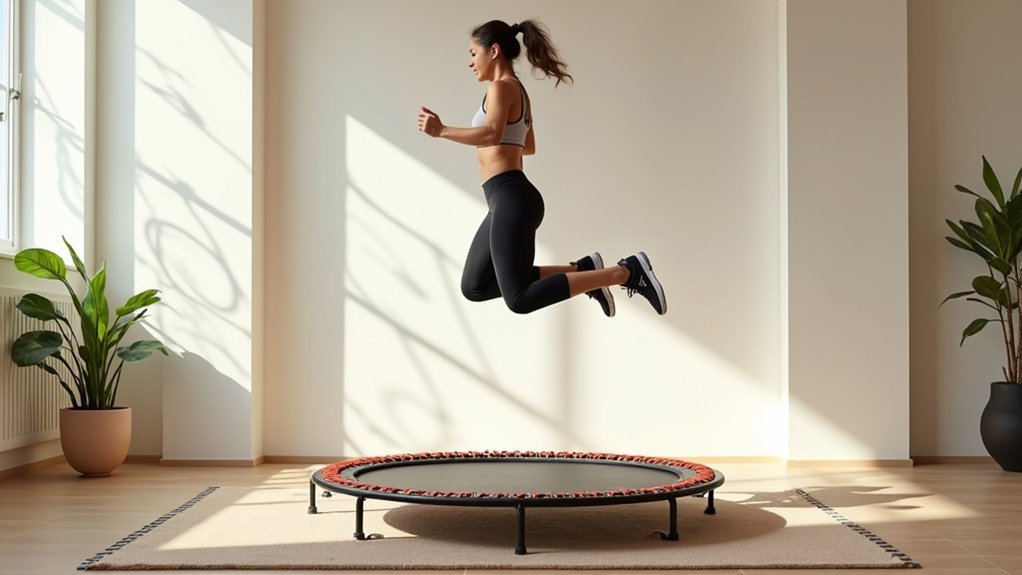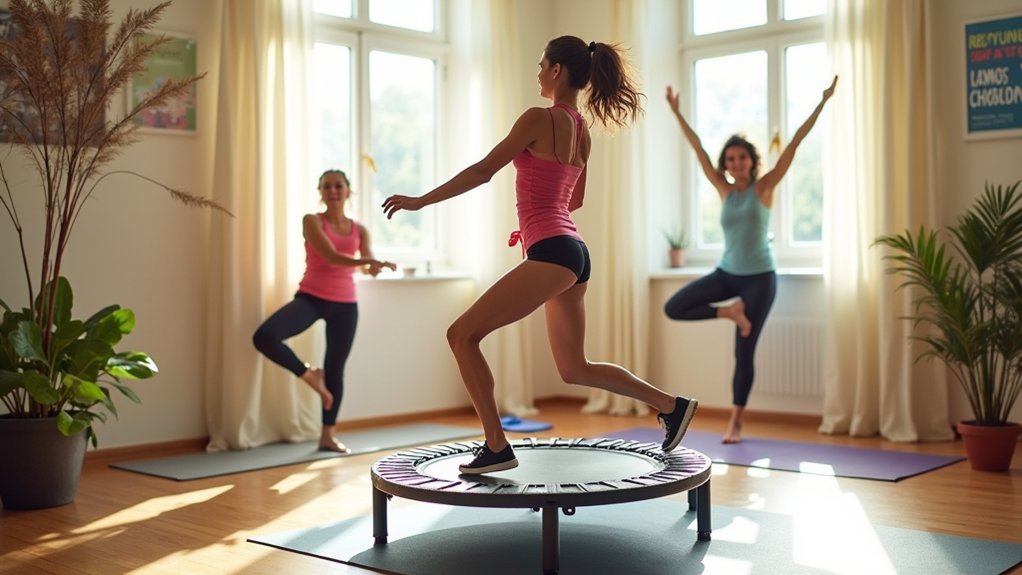Looking for rebounding workouts in your apartment? Try these three compact routines: a 10-minute Morning Energizer with basic bounces to kickstart circulation, a 25-minute Full-Body HIIT that burns 200-300 calories through high knees and twist jumps, or a 30-minute Low-Impact Cardio session perfect for beginners. Rebounders between 36-50 inches fit easily in small spaces and can be folded for storage. The extensive health benefits extend far beyond what their small footprint suggests.
Why Rebounding Is Perfect for Small Apartment Living

While many apartment dwellers struggle to find exercise options that won’t disturb neighbors or require extensive space, rebounding offers an ideal solution.
Mini trampolines fit easily in compact living rooms and can be quickly stored under beds or in closets when not in use.
You’ll appreciate the low-impact nature of rebounding—unlike running or jumping jacks, it won’t create loud thuds that disturb downstairs neighbors. Rebounding is also gentler on your body, putting less strain on the heart compared to higher-impact activities like running.
The lightweight, portable design means you can easily move your workout to different areas of your apartment or even outdoors.
With minimal investment, you’ll gain access to an exercise that requires no commute to the gym and adapts to your schedule, whether you have five minutes or thirty.
It’s the perfect fitness companion for urban living.
Choosing the Right Compact Rebounder for Your Space
When selecting a compact rebounder, you’ll need to evaluate diameter options between 36-50 inches to match your available floor space.
Look for models with foldable designs and included storage bags, such as the Fit Bounce Pro II, which can easily slip under a bed or into a closet when not in use. Consider rebounders with high weight capacity to ensure durability and stability during your workouts.
Test the bounce quality by comparing spring versus bungee models—springs offer energetic workouts while bungees provide quieter, more controlled movement that’s ideal for apartment settings.
Size Options Matter
Selecting the right rebounder size can dramatically impact your workout experience and space management. While rebounders typically range from 32 to 48 inches in diameter, your choice should align with your specific needs.
For minimal spaces, a 32-inch model provides basic functionality. Most users find 39 to 44-inch models offer an ideal balance for home workouts. If you’re taller or need extra movement room, consider a 45-inch or larger option. Many models like the Cloris Foldable Fitness Trampoline come with bungee cord systems that provide a gentler bounce for joints compared to metal springs.
Remember, quality trumps size—prioritize tension and bounce responsiveness over diameter. Smaller rebounders offer portability advantages, while larger ones provide softer bounces and accommodate more dynamic movements.
Before purchasing, measure your available space carefully and consider how frequently you’ll use and store your rebounder. Your budget and experience level should also influence your final decision.
Storage-Friendly Features
Beyond size considerations, storage-friendly features make a world of difference for urban dwellers and apartment fitness enthusiasts.
Look for rebounders with quarter-fold or half-fold mechanisms that compress to a fraction of their original size, perfect for tucking away in closets or under beds.
Detachable legs offer ultimate space efficiency—models with six screw-on legs can be completely disassembled for flat storage against walls or under furniture.
The lightest foldable options weigh just 28-34 pounds, making them easy to move between rooms.
Consider frames with bungee cord systems instead of bulky springs; these 42-loop designs maintain performance while reducing profile height. The commercial-grade fitness trampoline offers 42 bungee cord loops for optimal performance and durability.
For vertical storage limitations, note that models with stabilizer arms may reach nearly 45 inches when folded, potentially limiting where you can store them.
Bounce Quality Assessment
Though size matters considerably, the true measure of a compact rebounder lies in its bounce quality—the factor that determines both workout effectiveness and your long-term safety.
When evaluating rebounders, focus on tension type: bungee systems offer adjustable softness, while springs deliver tauter rebounds.
Your rebounder must match your weight—misaligned capacity risks instability and injury. Heavier individuals will need rebounders with adjustable tension settings to accommodate their body composition and prevent excessive sinking. Check that the frame remains stable during jumps with non-slip feet preventing wobble.
The jump surface should maintain even tension, with straight alignment markers indicating proper setup.
For apartment dwellers, consider noise levels—spring models typically produce more sound than bungee alternatives.
Finally, assess rebound responsiveness through high-knee exercises and jumping jacks during testing, ensuring there are no “dead spots” that might compromise your workout quality.
10-Minute Morning Energizer: A Quick Rebounding Routine
When you’re pressed for time but still want to energize your day, a minute morning rebounding routine can transform your physical and mental state. This quick workout boosts circulation, stimulates your lymphatic system, and releases mood-enhancing neurotransmitters that provide mental clarity. This efficient form of exercise is perfect for those seeking time efficiency while still getting comprehensive health benefits.
| Exercise | Duration | Benefit |
|---|---|---|
| Gentle bouncing | 20 seconds | Warms up joints and circulation |
| High knee lifts | 10 seconds | Increases heart rate and core engagement |
| Twist bounces | 10 seconds | Activates obliques and spine mobility |
| Sprint bouncing | 10 seconds | Maximizes cardio benefit |
| Cool-down bounce | 10 seconds | Gradually reduces heart rate |
You’ll enjoy improved insulin sensitivity, enhanced oxygen delivery, and better stress management—all while strengthening bones and muscles in a space-efficient, accessible workout that fits even the busiest schedule.
The 25-Minute Full-Body Rebounder HIIT Workout

Your rebounder HIIT workout will torch calories efficiently in just 25 minutes, making it perfect for busy schedules.
Set up your mini trampoline on a flat surface with at least two feet of clearance on all sides to prevent accidents during dynamic movements.
You’ll also want to keep a water bottle and towel nearby, as these high-intensity intervals will challenge your entire body despite the low-impact nature of rebounding. Remember to maintain proper form with your core tight, knees slightly bent and weight in your heels throughout each 45-second work period.
Efficient Calorie Burn
Despite its low-impact nature, rebounding delivers impressive calorie-burning results when structured as a HIIT workout. Following the 40/10 interval timing (40 seconds work, 10 seconds rest), you’ll burn between 200-300 calories in just 25 minutes—comparable to longer moderate-intensity sessions. Rebounding is proven to be more effective for calorie burning than typical cardio workouts like running, swimming, or cycling.
| Intensity Level | Calories/Minute | 25-Min Total |
|---|---|---|
| Light Bouncing | 6.9 | ~172 |
| Moderate HIIT | 9.5 | ~237 |
| Maximum Effort | 12.4 | ~310 |
Your weight influences these numbers considerably, with heavier individuals burning more. The real advantage comes from EPOC (afterburn effect), where your metabolism remains elevated post-workout. For maximum efficiency, combine explosive movements like tuck jumps with upper-body exercises like punches, gradually increasing height and speed as your stamina improves.
Equipment Setup Tips
Before maximizing your calorie burn with rebounding workouts, proper equipment setup guarantees both safety and effectiveness. Choose quality rebounders like Leaps & Rebounds or BCAN that fit your space—most are conveniently sized at around 40 inches in diameter.
When assembling, connect frame sections using the silver pegs while standing to apply ideal pressure. Verify all connections are secure. For the mat installation, note that Leaps & Rebounds logos should face upward, while BCAN logos face downward. Align the frame properly over the mat before attaching bungees. The step-by-step instructions from Leaps & Rebounds make assembly straightforward even for beginners.
Always clear your workout area of obstacles, verify that weight limits aren’t exceeded, and inspect your rebounder regularly for wear.
Start each session with gentle bounces to warm up, and you’ll be ready for an effective, space-efficient workout routine.
Low-Impact 30-Minute Cardio Session for Beginners
Getting started with rebounding workouts doesn’t have to mean high-impact moves or complicated routines. This beginner-friendly session focuses on joint-friendly movements while maximizing calorie burn.
Begin with a 3-minute warm-up of gentle step touches.
Then complete three 7-minute circuits, each containing:
- 1 minute of low-impact jumping jacks
- 1 minute of standing oblique crunches
- 1 minute of squat-to-jab combinations
- 1 minute of lateral shuffles
- 1 minute of skaters with controlled movements
- 1 minute of active recovery (walking in place)
- 1 minute of rest
Increase intensity by exaggerating arm motions rather than jumping higher. Remember that this workout emphasizes progress over perfection, so celebrate your small wins as you build consistency.
You’ll engage your core throughout while avoiding floor exercises, making this perfect for small spaces and protecting your wrists.
Maximizing Health Benefits in Minimal Square Footage

Living in compact spaces shouldn’t limit your fitness potential. With just a 36-inch rebounder, you’ll activate multiple body systems simultaneously while maintaining a tiny footprint. Position your mini-trampoline strategically to maximize both vertical and horizontal space utilization. Unlike large backyard trampolines, these indoor rebounders provide safer exercise options for adults with limited space.
| Benefit Category | Small Space Strategy | Time Efficiency |
|---|---|---|
| Lymphatic Flow | Alternate between bouncing and twisting motions | 5-7 minutes daily |
| Bone Density | Add light hand weights during basic bounces | 10 minutes, 3x weekly |
| Cardiovascular | HIIT intervals with high knees and jogs | 15 minutes, 2x weekly |
| Neuromuscular | Practice single-leg balance holds between sets | 2-3 minutes between exercises |
You’ll achieve thorough health improvements without sacrificing square footage, as rebounding’s multisystem stimulation delivers efficiency impossible with traditional cardio equipment requiring considerably more room.
Frequently Asked Questions
Can Rebounding Workouts Aggravate Existing Joint or Back Problems?
While rebounding’s low-impact nature protects joints and can strengthen your back, you’ll need proper form to avoid aggravating existing conditions. Always consult your healthcare provider before starting if you have joint or back problems.
How Long Does a Typical Compact Rebounder Last Before Needing Replacement?
A typical compact rebounder lasts 3-8 years depending on quality. You’ll get more life from high-quality models with proper maintenance. Budget options may need replacement after 2-3 years of regular use.
Are Rebounding Workouts Safe During Pregnancy?
Rebounding can be safe during pregnancy with your doctor’s approval. You’ll need to modify your routine—focus on gentle bounces, engage your pelvic floor, and listen to your body’s signals. Stop immediately if you feel discomfort.
Can Children Safely Use Adult Rebounders for Exercise?
Yes, children can safely use adult rebounders with proper precautions. You’ll need to supervise them, guarantee they’re over 10 years old, check the weight limit, and adjust handlebars appropriately for their height.
Does Rebounding Help With Lymphatic Drainage and Immune System Function?
Rebounding does promote lymphatic drainage through gravitational changes that stimulate fluid movement. While you’ll enjoy better circulation during bouncing, scientific evidence specifically linking rebounding to enhanced immune function remains mostly anecdotal rather than conclusively proven.
In Summary
You’ve now got three effective rebounding routines that fit perfectly into your space-challenged lifestyle. Remember, you don’t need a sprawling home gym to get amazing results. With just a compact rebounder and these targeted workouts, you’ll boost your cardiovascular health, strengthen your muscles, and improve your balance—all while protecting your joints. Start bouncing today and watch your fitness soar, regardless of your square footage!





Leave a Reply